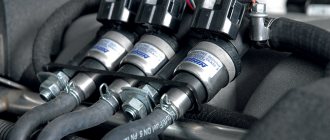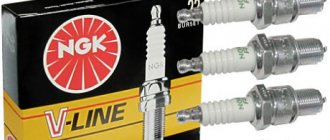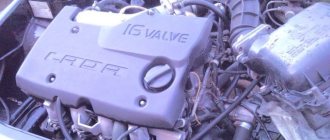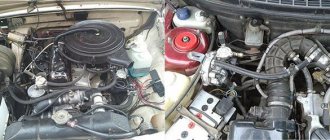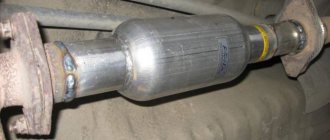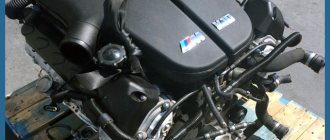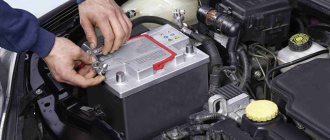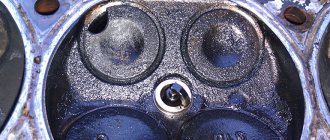What are oil shock absorbers
Twin-tube oil shock absorber.
Oil (liquid, hydraulic) shock absorbers are used on passenger cars in more than half of the cases. They are designed quite simply: there is a cylindrical chamber filled with oil, and a piston with small through holes moves in it, dividing the chamber into two parts. When hitting a bump, the shock absorber compresses - oil flows through the holes in the piston from one part of the chamber to another. This is a relatively slow process, thanks to which the oil smoothes out vibrations and softens shocks.
Advantages:
- they are quite simple to produce, therefore, as a rule, they are significantly cheaper than other types;
- they can be repaired without any problems in case of problems or even restored if they are in a very worn state;
- provide good softness of movement due to high compliance - they can be squeezed with bare hands;
- in general, their dimensions are much smaller than those of gas shock absorbers.
Flaws:
- high softness results in excessive body sway and instability in corners, especially at high speed;
- When driving, the oil heats up and fills with air bubbles, which makes the shock absorbers even more pliable;
- at low temperatures, the oil thickens, and as a result, the suspension becomes stiff;
- Oil shock absorbers cannot boast of particular durability; they are sensitive to the slightest deformation.
Construction of gas and oil shock absorbers
The vast majority of shock absorbers for passenger cars today are represented by gas and oil types. Let's figure out how each of them works:
- An oil shock absorber is a traditional type of shock absorber and the simplest of all. It consists of a cylinder and a rod with a piston, which divides the cylinder into two cavities. The internal cavity of the cylinder is filled with oil. The piston has bypass holes with valves. As the rod moves, oil flows through the valves in the piston from one cavity to another. Due to this, vibrations of the springs or springs of the car are dampened after driving over uneven surfaces.
- A gas shock absorber consists of a cylinder, a rod with a piston and a so-called floating piston, which is installed at the bottom of the shock absorber and divides the cylinder into two parts. He can move freely. There is gas in the lower part under the floating piston. The pressure in the gas chamber can reach 30 atm. The cavity above the floating piston is completely filled with oil. It is also divided into two parts by a piston connected to a rod.
There is also a gas-oil shock absorber. It consists of two cylinders: internal and external. The inner cylinder is filled with oil, and a piston with a rod moves in it. In the upper part of the outer cylinder there is a gas (usually nitrogen) under a pressure of up to 8 atm. The lower part of the outer cylinder is filled with oil and is connected through bypass valves to the inner one.
Today, gas and gas-oil shock absorbers are gradually replacing traditional oil-based options from the market. Our consultants can always help you with your choice.
Expert help
What are gas shock absorbers
Monotube gas shock absorber.
What are called gas shock absorbers are actually the same hydraulic, oil shock absorbers, only with the addition of a pneumatic chamber. There are no shock absorbers that use only gas. At least in the mass industry aimed at passenger cars. In fact, any gas shock absorber is gas-oil. But for convenience, they are divided into two separate types, because they are structured differently.
There is also nothing complicated in the design of gas shock absorbers - almost everything is the same as in liquid shock absorbers, only another chamber with highly compressed gas is added, usually nitrogen. It turns out that during compression, energy is absorbed not only and not even so much by the oil, but by this very compressed gas.
Advantages:
- they are, as a rule, very rigid, due to which they give the car excellent stability and controllability;
- they can withstand heat or low temperatures much more easily, without losing their performance properties so much;
- can unclench independently and generally react faster to changes in the level of the road surface;
- 30-50 percent more durable than purely hydraulic shock absorbers.
Flaws:
- due to their extreme rigidity, it can be problematic to use them even in the city - the slightest unevenness is clearly felt;
- transferring all the vibrations to the body, such shock absorbers wear out the body and interior parts more, and generate a lot of noise;
- on rough roads they contribute to rapid wear of the suspension;
- their cost is significantly higher than that of oil shock absorbers.
Can gas-oil shock absorbers replace other types?
Gas shock absorbers are a type of shock-absorbing device whose compensation chamber is filled with gas pumped under high pressure. This forces the piston to always be pressed. Gas-filled shock absorbers, due to their rigidity, which does not change linearly, allow the car to stay on the road more confidently even when driving at high speed. This is their main advantage compared to oil ones. Gas-filled shock absorbers do not change their characteristics when the temperature changes, which will not lead to their heating when the car is moving for a long time, especially in the summer, and will not affect their operation in the winter. This type of device has a fairly long service life.
Their main disadvantage is the price. Compared to oil-based ones, they are about 30% more expensive! Also, their increased rigidity leads to increased load on the body, which can negatively affect the strength of its metal parts.
Oil shock absorbers are in greatest demand today among motorists. The resistance force also depends on the speed of movement of the rod in them. Oil shock absorbers implement the reciprocating movement of the car piston. Through this piston, oil is transferred from one part to another. Thus, vibrations are damped, while the resistance of the springs takes over the oil. The main advantages of hydraulic shock absorbers are: fairly affordable price and relatively small size.
We recommend: Crankshaft - what is it and how does it work?
Oil shock absorbers have disadvantages, including:
- The compensation chamber contains an air mixture. The device will not work effectively if there is low or no air level. If there is too much air, the shock absorber will compress without resistance.
- Low level of heat transfer. There is a possibility of overheating of the oil fluid in the shock absorber, which will lead to the loss of its binding properties. This may happen during a long trip.
- Reduced vehicle operating efficiency on rough roads. The piston begins to move sharply and frequently, which leads to mixing of oil with air bubbles. At the same time, the viscosity of the oil decreases, which can either damage the shock absorber or negatively affect its operation.
A gas-oil shock absorber (combined) is a device that combines both oil and gas. In structure it is similar to a hydraulic shock absorber, but differs in the contents of the outer cylinder - instead of air, there is gas there. Damping of vibrations occurs with the help of oil, while the function of the gas is to eliminate foaming. The gas-oil shock absorber allows you to use the positive properties of a gas-containing shock absorber, such as rigidity, which is necessary under heavy loads, while it combines them with the softness at small loads characteristic of an oil shock absorber. This allows you not to break through it, while reducing the braking distance by several meters. A gas-oil shock absorber, in the outer flask of which gas is under pressure, reduces the aeration process to a minimum. There are no special problems in its maintenance and the price is quite low. Despite all the advantages, the gas-oil shock absorber still has disadvantages. It is impossible to install it in the so-called “upside down” position, because there is gas in the outer flask.
And yet, after analyzing all the disadvantages and advantages of different types of shock-absorbing devices, the buyer will have to decide which shock absorbers are best.
What are gas-oil shock absorbers
Gas-oil shock absorber.
As mentioned above, gas and gas-oil shock absorbers are essentially the same thing, the only difference is in the design. The gas-oil shock absorber uses two chambers, a cylinder within a cylinder. When compressed, the oil flows from the inner chamber to the outer one, where it rests against a partition, behind which there is a chamber with gas. This achieves some compromise between the features of a gas and oil shock absorber.
The advantages and disadvantages of gas-oil shock absorbers are identical to those of oil and gas shock absorbers, the only difference is that in gas-oil shock absorbers they are much less pronounced:
- nitrogen pressure is several times lower than in gas ones, making them much softer, but at the same time harder than oil ones;
- the price of gas-oil shock absorbers is most often something in between - cheaper than gas shock absorbers, more expensive than hydraulic ones;
- are subject to deterioration in performance due to temperature changes, although to a lesser extent than fully oil shock absorbers.
Which shock absorbers are better and in what cases
If we are talking about using a car according to the most popular scenario such as “80% city and 20% country trips,” then gas-oil shock absorbers are the golden mean. They provide good stability and handling without making people in the car feel like they're riding a cart on a washboard. Nitrogen prevents the oil from boiling and gassing, so this design is quite resistant to rough roads and long trips.
Oil shock absorbers are especially good in conditions of bad roads or complete off-road conditions. That is, this is the clear choice of people who live outside the city. Another argument in favor of this choice is the low price. Even against the backdrop of a slightly shorter service life, this is a very profitable purchase.
And gas shock absorbers are the choice of uncompromising car owners who live in big cities with good roads and want to get maximum dynamics and controllability. Most often, such models are installed on sports cars or tuned cars. Driving with high-quality gas shock absorbers is really similar to driving a sports car - the car responds sensitively to the steering wheel and practically does not roll when cornering.
There is also a “limited tuning” option, when gas shock absorbers are installed on the front wheels for better handling, and gas-oil shock absorbers are installed on the rear wheels for greater softness. But the meaning of such mixing is rather questionable, because the hard front end perfectly transfers all the unevenness to the interior, and softer rear shock absorbers do little to improve the situation.
Advantages
The main positive quality that a gas-oil shock absorber has is its rigidity. But this quality can easily turn into a negative one if the car drives on uneven surfaces. In this case, the car and the driver, together with the passengers, will feel all the bumps and irregularities. Therefore, it is worth choosing a mechanism depending on which roads the car will be on.
The ability to change the compression range is a characteristic that is characteristic of the device in question. This parameter indicates that during operation the shock absorber can adapt to the type of ride and change the working area. Since gas, even at very high pressure, can be compressed, it will add elasticity to the machine.
We recommend: Non-contact ignition system (BSI)
Another advantage that a gas-oil shock absorber has is its price. With such numerous positive qualities, it is not so high, especially considering that there are different manufacturers and suppliers who offer different brands and trademarks.
These positive aspects that the gas-oil type of devices have influence the choice of the car owner. But you should definitely look at the recommended rules from the car manufacturer. After all, only the creator of the car can know about all its parameters, take them into account when driving and know the results of all tests performed. Do not go against the recommendations given in the instruction manual. This can cause premature wear and tear on your machine.
When choosing such mechanisms, it is also worth considering that a gas-oil shock absorber requires pumping before installation. This method allows you to extend the service life of the device by almost half. And given the fact that the gas-oil shock absorber cannot be repaired, such pumping is simply necessary for the device.
If the car owner’s choice is aimed specifically at this type of mechanism, then it is worth taking into account the fact that the gas device must be installed only in a vertical position. These are the requirements of the gas so that it takes the correct position relative to the oil. Therefore, there is a big recommendation for buyers - so as not to have to go to another repair, the installation should be of the highest quality and exclusively in a vertical position.
Video on the topic
Related publications
- What is a differential in a car and how does it work?
- EGR in a diesel engine: what is it?
- Front strut support bearing: what is it and what is it for?
- Power steering: what is it in a car
Leave a review
Cancel reply
